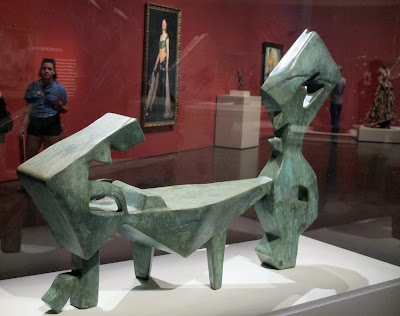Rhythm and Roots is certainly a different exhibition and concept. The show tells a story of the influences, evolution and traditions of dance in the United States with a collection of drawings, paintings, photographs, sculptures and costumes dating from 1830 to 1960.
Dances by Arthur Bowen Davies - 1914. I love the movement and colors of this particular painting. Forgot to get a better photo, there was a tour at the moment and I had to shoot around a big crowd.The Harvest Dance - Joseph Henry Sharp - 1893.
There was a section showcasing ceremonial and rituals dances of the American Indian as a big part of their spiritual life.
Indian Dancers by Jan Matulka - 1917 is a great strong piece. You need to step back to really appreciate its movement.
The Sidewalk Dance by John George Brown - 1894 - shows children dancing a traditional step to the man playing the hurdy-gurdy. A dance step common to the Irish, Germans, Italians...
The Charleston by Frank Myers - 1926. One can just feel the dancers swinging around on the crowded dance floor doing the Charleston.
Dancing Lesson by Raphael Soyer - 1926. I love the folk art sense to this painting. It is a memory of Soyer's of his sister teaching his twin brother to dance while his mother puts down his Yiddish newspaper to watch along with the rest of the family. The youngest brothers adds a little music by playing his harmonica. Truly is a piece of history portraying three generations.
Dancer and Gazelles by Paul Manship - 1916. I particularly like Manship's work. One of my favorite pieces of his can be found at the National Museum of Wildlife in Jackson, Wyoming titled Indian and Pronghorn Antelope - 1914. He studied at the American Academy in Rome where his style was strongly influenced by the Roman, Greek and Egyptian works. Such refined, delicate work with a beautiful Art Nouveau style.
Youth by Arthur F. Mathews - 1917. He beautifully portrayed the nine muses of Greek mythology. Urania, the muse of astronomy leads the group clanging her cymbals while dressed in a gold-colored skirt decorated with the signs of the zodiac.
The Jolly Flatboatmen by George Caleb Bingham - 1846. The artists celebrated the life of the working men who transported supplies and goods along the Missouri River. To take a break and entertain each other as they would dance a jig or two. This whole scene reminded me of the old 1950's musical, Seven Brides For Seven Brothers; It's a story set in 1850 Oregon, when a backwoodsman brings a wife home to his farm and his six brothers decide that they want to get married too.
Plumes by Walt Kuhn - 1931. Kuhn was most famous for his portraits, especially those of circus performers and vaudeville entertainers. He would use them as models and painted them differently of what one would see on stage, the models seemed detached from their cheerful performing arena and to be staring intently out at the viewer.
Portrait of Katherine Dunham by Werner Philipp - 1943. Dunham was an anthropologist and one of the greatest modern dancers of the time in the United States and Europe. She had an unique style that was influenced by her research of Afro-Caribbean dance combined with jazz and ballet.
La Carmencita - John Singer Sargent - 1890
The Spanish dancer, Carmencita (also known as the Pearl of Seville), was famous in the 1980's in Spain and France. Her popularity was so immense, that when she came to New York, she was inundated with requests for private performances. Sargent certainly captured her energy with this dramatic pose and elegant dress.
Terpsichore and Euterpe - David Smith - 1947
This bronze represents the strong and angular gestures of modern dancers of his time. Terpsichore was the muse of dance and Euterpe shown playing the piano was the muse of music.
The Egyptian Dancers - Anne Estelle Rice - 1910
Inspired by the Russian Ballet's performance of Cleopatra.
Russian Ballet - Max Weber - 1916
Weber was also influenced by the Russian ballet's colorful set design as seen in the above painting. Dance and movement was a common theme in many of his works.
In the late 1920's Diego Rivera designed many of the costumes for the American Ballet H.P.
(Horse Power). In this ballet, the industrial skills of the United Stated meets the agricultural of South America. A ballet that was only performed once in 1932 and was not recorded.
I would have loved to see how the costumes were executed!
It is an exhibition showcasing many more works that I have not even touched on.
Denver Art Museum
Exhibit runs through October 2.




















No comments:
Post a Comment